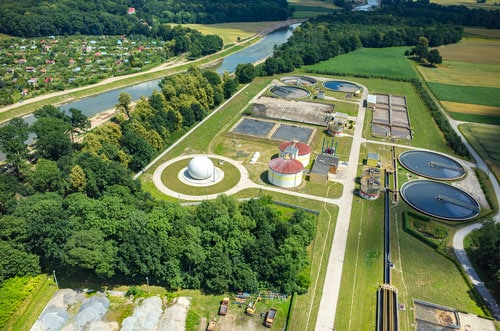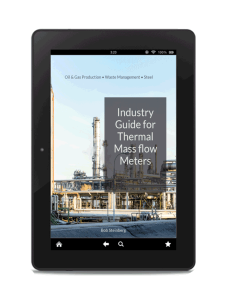Wastewater treatment removes contaminants from wastewater, primarily sewage, and returns the treated effluent or discharge to the environment. The consistency of wastewater will vary in different areas depending on the mix of household sewage and industrial waste. There are multiple stages in wastewater treatment that have become more involved as technology has developed. The exact process and types of equipment will vary between different plants.
Thermal mass flow meters play a significant role in obtaining efficient operation of the various stages of wastewater treatment:

Aeration Air
The secondary treatment of wastewater is reducing the organic material in the water. By introducing air or oxygen into the wastewater, we promote microorganism growth that breaks down organic material. This process is frequently accomplished using an activated sludge process and aeration basins introducing air into the wastewater through submerged piping and aeration nozzles.
At one time, the standard in the industry was “the more aeration air flow-the better!” However, the more efficient operation occurs when the air flow to different sections of the aeration basin is balanced. Thermal mass flow meters are ideal for monitoring the flow to each segment of the aeration tank.
As energy costs increase, wastewater treatment plants have begun to control the air flow to the different parts of the aeration basin to obtain the desired dissolved oxygen (DO) content. In some cases, the total flow to all aeration basins is measured. However, we can achieve better control by measuring and controlling the flow to each section of the aeration basin, providing a further reduction in energy usage.
Learn more about aeration flow in the Sage application brief, Aeration Airflow at Wastewater Treatment Plants.
Digester Gas

Sludge from the primary and secondary treatment stages is a byproduct of wastewater treatment. The sludge is further broken down in the absence of air with anaerobic digesters and produces digester gas (biogas) which is a mixture of methane and carbon dioxide with small amounts of other gases, including hydrogen sulfide, nitrogen, and trace amounts of other gases. Digester gas is wet and dirty. The ratio of the gases will vary but typically is 65% methane 35% carbon dioxide.
The biogas can be used as a fuel to produce energy for the facility. If a facility lacks the engine to generate the energy or too much biogas is created, the biogas is sent to a flare to burn off. Measurement of the biogas flow rate indicates both the digester’s and engine’s operation.
Many different types of flow meters have been attempted to measure digester gas flow. The challenge, of course, is that digester gas often has a low velocity, and many flow meters cannot detect its flow. Additionally, some flow meters become plugged with buildup and create ongoing maintenance difficulties.
Odor Control Systems
Wastewater treatment plants produce odor, especially in the initial stages of the process. Since some wastewater facilities are located near residential areas, odor reduction systems are installed. These systems may involve covering equipment such as raw sewage influent pump stations, raw sewage clarifiers, and aeration basins, and sludge thickeners. The odorous gas, hydrogen sulfide, is pulled through ductwork, to a fan, through a treatment device, and discharged into the atmosphere. The treatment device may be a carbon filter, wet scrubber, or similar equipment.
Flow meters are used in each section of ductwork to ensure a sufficient amount of odorous air is removed from each section and that the total flow rate does not overload the primary odor control device.
Thermal Mass Flow Meter Advantages
For all these wastewater treatment plant applications, thermal mass flow meters offer:
-
- Mass flow measurement provides consistency with varying pressure and temperature.
- Easy installation in pipe or ductwork
- Remote mount available for local display of flow rate
- Thermal mass meters can detect and measure very low flow rates; at velocities less than many other flow meters
- An insertion-style meter can easily be removed from a pipe for cleaning and maintenance using a suitable retraction device (if required)
- Suitable in hazardous areas
- Virtually no pressure drop
- High rangeability
- Linear output signal

